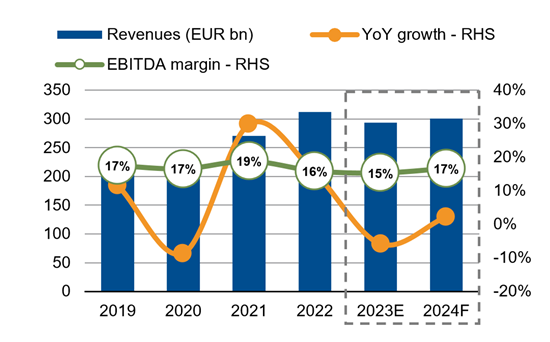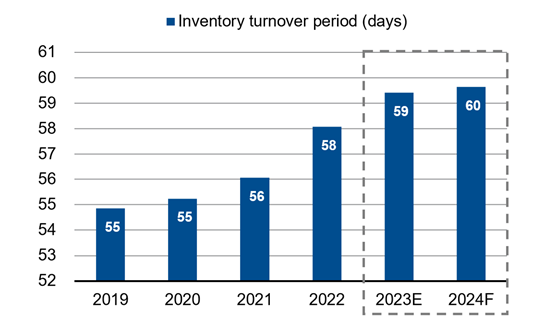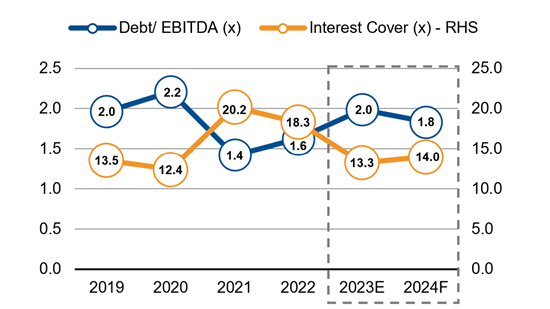Announcements
Drinks
Chemicals sector outlook shifts to negative from stable: cost control, cash preservation in focus
By Iván Castro Campos and Nidhi Marwaha, Corporate Ratings
Cost control and protecting cash flow are still industry priorities, visible in the postponement of some capital expenditure and reductions in dividends, limiting any worsening in credit metrics.
The business outlook is more stable, with all companies in the sector confronting the after-effects of the pandemic and Russia’s escalation of its war in Ukraine in 2022. Within the European sector and the generalised pressure on credit metrics, we do not foresee significant changes in market shares. Companies with geographically diversified production will benefit from being relatively less exposed to Europe’s high energy prices than purely Europe-based rivals. Cost cutting will drive a likely only modest improvement in profitability this year compared with 2023.

Prolonged downturn as destocking continues
The downturn experienced by the chemicals sector since late 2022 will persist in 2024, with no recovery until well into 2025 (Figure 1). Aggregate revenues for the 18 companies that we cover will stagnate at 2023 levels. The lack of revenue growth is common to the sector except for those firms with annual cost pass-through agreements, typical of industrial gas suppliers such as France’s Air Liquide SA.
The main contributor to the deficiency in topline growth is customer destocking, with roots going back to the overstocking during the Covid pandemic. Despite the European chemicals sector's well-diversified profile, encompassing geographical diversity and a clientele from various industries, the problem of excess inventory is lingering. Consequently, the persistent lack of topline growth poses a significant challenge for the sector, requiring strategic rather than ad-hoc solutions.
Figure 1: Profitability decline in 2023, marginal 2024 recovery amid persistently high energy costs

Sources: Scope Ratings estimates
Industrial consumers of chemicals changed the way they managed inventory in the pandemic, moving from “just in time” to “just in case”, which led to a build-up in stocks and subsequent reduction in new demand as economic growth slowed. Even though the pandemic is behind us, inventory levels in the chemicals sector are yet to return to pre-Covid norms (Figure 2)
Figure 2: Inventory levels expected to return to normal levels after 2024

Source: Scope Ratings estimates
Higher interest rates in past two years have not helped. It has made economic sense for customers to liquidate inventories rather than finance them, in turn affecting the performance of the European chemicals industry. Aggregate Scope-adjusted debt as a multiple of EBITDA for the companies we cover rose 2.5x in 2023, back up at the levels in 2020 at the height of the pandemic (Figure 3).
Nevertheless, a likely economic recovery in 2024, bolstered by possible interest rate cuts, should start to rub off on the sector, even if this recovery may not materialise for European companies until well into 2025, hence our negative credit outlook.
Figure 3: Financial metrics deteriorated in 2023, set for partial recovery in 2024

Source: Scope Ratings estimates
Evidence of the pressure facing European companies is widespread. German specialty chemicals supplier Lanxess SA reported unprecedented low capacity-utilisation rate last year. Management forecasts that a return to the break-even point in terms of capacity utilisation could take place in 2025 but might happen only in 2026.
Among firms re-assessing investment plans, integrated chemicals supplier BASF SE has cut capex by EUR 4bn, with likely a long-term impact on revenue growth, which will not be as strong as initially forecast.
Profit margins recover only slightly as energy costs remain high
Profitability will improve only a little for Europe’s chemical companies this year. We forecast aggregate Scope-adjusted EBITDA margins of 15.2%, up from 13.6% last year, but well below the 18% recorded in 2021. The modest recovery in 2024 will result from operational cost savings, job losses and deferrals of non-essential expenditure.
However, companies will likely have to find deeper savings or risk some deterioration in credit quality. Energy costs, a major expense for the sector, will be hard to compress as European electricity utilities have locked in elevated prices for 2024-26.
The picture looks brighter from next year on when profitability should improve for the European sector. First, the return to more normal inventory management will bolster demand. Secondly, structural transformations in the industry unfolding during 2024 will help corporate performance in 2025 through improved cost control and better cost absorption, the latter linked to higher utilisation of industrial capacity.
Three cases exemplify this transformation. First, if the Abu Dhabi National Oil Co. (Adnoc) completes its planned EUR 11bn acquisition of Covestro AG, the United Arab Emirates firm has said its primary objective is to focus on developing high-value projects, pointing to an improvement in future profit margins.
Secondly, Bayer SE is looking at a potential split between its pharmaceutical and agricultural chemicals arms, potentially helping improve the performance of both businesses. Thirdly, specialty chemicals company Syensqo SA, spun off from Belgian firm Solvay SA, aims to focus on innovative sectors such as electric car batteries, lightweight plastics, and green hydrogen, likely resulting in slightly increased profitability this year, with a bigger improvement in 2025.
To download the full Corporates Outlook 2024, please follow this link.
Webinar: Tuesday, 20 February at 15:30 CET
Please join Scope Ratings analysts for an in-depth discussion of the European corporate credit outlook for 2024 by registering here.
Access all Scope rating & research reports on ScopeOne, Scope’s digital marketplace, which includes API solutions for Scope’s credit rating feed, providing institutional clients access to Scope’s corporate, bank, sovereign and public sector ratings.







